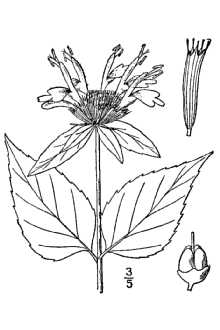Purple Bergamot
Scientific Name: Monarda media Willd.

| General Information | |
|---|---|
| Usda Symbol | MOME |
| Group | Dicot |
| Life Cycle | Perennial |
| Growth Habits | Forb/herb |
| Native Locations | MOME |
Plant Guide
Use soil moisture sensors to measure the soil moisture of Purple Bergamot.
Fact Sheet
Alternate Names
Purple bee balm and Horsemint
Uses
Ethnobotanical: Monarda species were used by a number of Native American tribes to cure skin eruptions, reduce fevers and treat colds. Landscaping and wildlife: Purple Bergamot is an adaptable, easy to grow wildflower for moist, sunny to light shade locations. It is a moderate spreader which will form a substantial colony. It is a native and can be part of a good wildlife seed mixture where native grasses and wildflowers are seeded together. The common name bee balm resulted from the attraction of bees by the fragrance. Many kinds of bees, butterflies (especially Fritillaries) and hummingbirds use the curved tubular flowers for nectar. The seeds are eaten by goldfinches and other seed eating birds. It is deer resistant and ideal for rain gardens and other plantings in moist areas (such as wood edges).
Status
Please consult the PLANTS Web site and your State Department of Natural Resources for this plant’s current status (e.g., threatened or endangered species, state noxious status, and wetland indicator values).
Description and Adaptation
Adaptation
Adaptation
Purple Bergamot is perennial wildflower that grows 2 – 3 feet tall. It is a member of the mint family, and has square stems. The leaves have a strong mint fragrance when crushed. Its leaves are oblong and pointed (lanceolate) and placed opposite one another on the stems, and the stems are topped by a cluster of reddish purple tubular flowers that bloom in summer. The small leaves at the base of each flower (bracts) are also purple or purplish. Purple Bergamot spreads through rhizomes (horizontal underground stems that produce new plants). Purple Bergamot can be found growing in swampy thickets, stream beds and ditches. Purple Bergamot distribution from USDA-NRCS PLANTS Database. For updated distribution, please consult the Plant Profile page for this species on the PLANTS Web site.
Establishment
General: Purple Bergamot can be started by seeds, softwood cuttings or by dividing the clumps in the spring, Collect seed heads in fall and spread them over a clean, dry surface indoors to dry for several days, Then place the seed heads in a paper bag and shake them, The seeds will fall out of the seed heads and into the bag, Then run the seeds and associated chaff through a sieve, Store the seeds in a dry sealed and labeled container or reseal able storage bag with wet sand or peat moss at 38 - 40 degrees F for 3 months, Propagation by seeds: Seeds sown in flats during January and stored in a greenhouse are expected to germinate in 1 to 2 weeks, The soil mix can be 1/3 sand and 2/3 commercial plug mix, Apply a starter fertilizer solution for the seedlings, Water flats when the soil surface is dry to the touch, Keep the seedlings in the flats for 6 - 7 weeks and then transplant them to 3-inch pots, Pinch off the tops of the plants several times during the growing season to encourage branching and a bushier grow habit, Apply an all-purpose fertilizer for the transplants on a weekly basis, When the roots fill the container (about 2 months), they are ready for out planting in the garden, Seedlings should be planted into a sunny, weed-free, well-drained soil about 1,5 to 2 feet apart, Use soil moisture sensors to measure the soil moisture of Purple Bergamot., Water weekly during droughty conditions for the first 2 seasons, Seeds can also be broadcast on a weed-free surface from January to mid-May in sunny locations, Once the seeds germinate, seedlings should be watered during extended dry periods, If weeds are a problem during the first summer of growth, mow the area 3 to 5 times to a height of 4 and 8 inches to reduce weed competition, Propagation by cuttings: Take 3- to 4-inch long stem tip cuttings at any time from May to August, Remove the lower leaves and all flower or seed heads and insert the stems into a sand and perlite rooting medium, Bury each cutting up to the first node, Place the cuttings in an enclosed area and mist them several times a day, In 4 to 5 weeks the cuttings should be well rooted and can be transplanted to pots, Transplant to the garden in the early autumn,
Management
Purple Bergamot prefers damp, acidic soil. Once established, Purple Bergamot still benefits from extra watering during dry summers. Mowing in spring after woody plants leaf out will reduce woody plant encroachment. Delaying mowing until spring will also leave seed heads standing for seed eating birds and other wildlife. In a garden plants will spread quickly through rhizomes; plants may be divided every three years.
Pests and Potential Problems
Purple Bergamot foliage can be infected with powdery mildew and rust in humid climates or when the clumps become too large and air circulation is reduced. These diseases discolor the foliage and cause the plants to lose their leaves prematurately. This is mainly an aesthetic problem and rarely causes long term problems for the plant. Cultivars, Improved, and Selected Materials (and area of origin) There are no recommended cultivars or selected materials at this time.
Prepared By
Samantha Kirk and Shawn Belt, NRCS, Norman A. Berg National Plant Materials Center, Beltsville, MD
